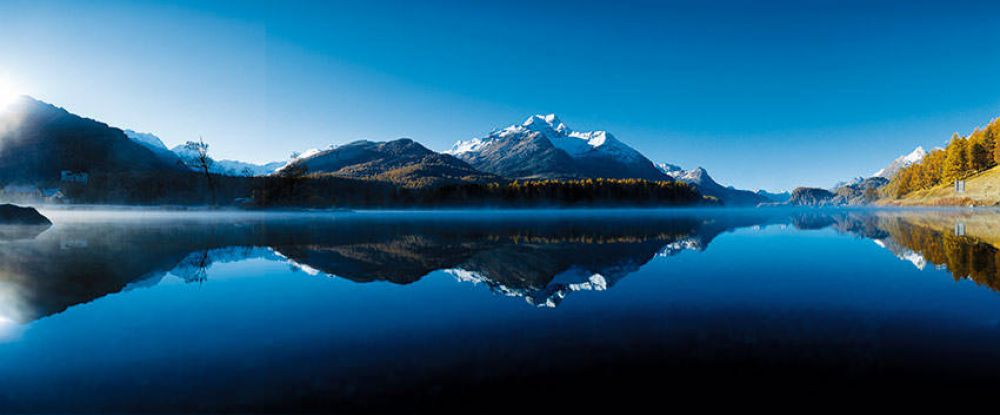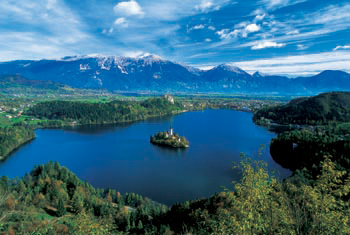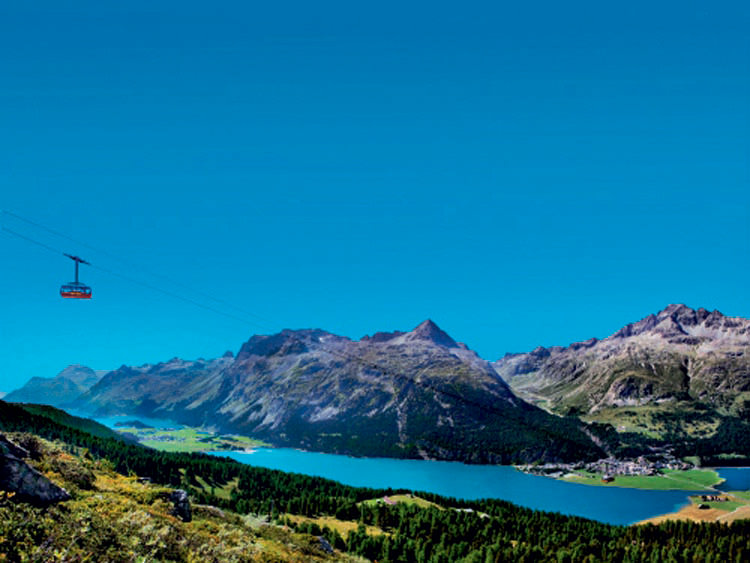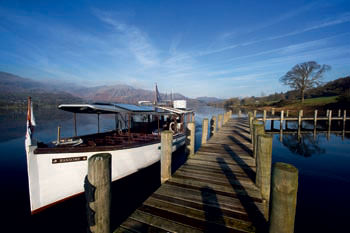Lake Districts From Around the World
What better way to spend the summer than retreat to the lakes for some clean air and stunning scenery. Jane Labous leads the way to some of her favourites…

What better way to spend the summer than retreat to the lakes for some clean air and stunning scenery. Jane Labous leads the way to some of her favourites…
This glacial lake high in the Julian Alps is particularly beautiful in the mornings, as the mists clear and the bells ring out from the island church. The setting is spectacular – behind rise the towering peaks of Mount Stol and Mount Triglav, while perched high on a cliff is Bled Castle, a medieval fortress with enough pointed towers and ramparts (there’s even a drawbridge) to satisfy the most demanding of Rapunzels.
Walking around Bled doesn’t take more than a couple of hours, and there are plenty of picnicking spots beneath the willows. Pack your hamper with local foods such as dried pork and pršut (air-dried ham); potica (walnut rolls), and dumplings filled with cottage cheese. And you can’t visit Lake Bled without trying a kremna rezina, a Slovenian cream slice.
After lunch, take the public gondola to Bled Island, where the baroque church has a 15th-century belfry with a ‘wishing bell’ for visitors to ring. There are all sorts of activities to take part in here, from horse-riding to rock climbing and fishing. An evening hike from the south-west corner of the lake to the 756m summit of Velika Osojnica will reward you with sunset views of Bled, its castle and the island, with the pinnacle of Mount Karavanke in the distance.
Bed down at the Mayer Pension, which has a restaurant serving fresh lake trout – plus a wine cellar stacked with Slovenian varieties such as riesling from the north-east and refošk from Primorska. President Tito’s palatial former home on the shores of Lake Bled is now a luxurious hotel, Vila Bled. Here, chef Igor Jagodic uses pikeperch from the river and local venison, while the exquisite Belvedere Pavilion is a romantic setting for enjoying blueberry schnapps and prekmurska gibanica, a layer cake of cream cheese, apple and nuts.

EasyJet (easyjet.com) flies from Stansted to Ljubljana from £40 return including taxes. Mayer Pension has doubles from £60 per night with breakfast (mayersp.si), while doubles at Vila Bled cost from £120 per night (vilabled.com).
For a century or more St Moritz, in Switzerland’s Engadin Valley, has been the winter retreat of Hollywood stars, minor European royalty and the international jet set. But this sapphire lake gets an average of 322 days of alpine sunshine every year – and summer is the time when the Swiss come to hike and cycle its 580km of mountain paths. Base yourself at the historic Kulm Hotel (it opened in 1856) and you’re right in the heart of town, with views across the lake and mountains.
There are three aerial cableways which take you up to the peaks of Corviglia, Signal and Muottas Muragl, where you can hike, cycle or picnic in the shade of the Stazerwald forest. Up here, mountain restaurants offer fondue, raclette and Engadin nusstorte, a nut cake made from caramel and walnuts. And at teatime, Hanselmann’s on Via Maistra 8 (hanselmann.ch) is always full of hungry hikers eating birnbrot, a local cake filled with dried fruit, or home-made pralines.
The Morteratsch dairy in nearby Pontresina was once one of the Alps’ most famous cheesemakers, and has recently started producing cheese again in the traditional way. It makes for an interesting day trip; you can watch the artisan process and enjoy a fondue for lunch. Nearby, the small Engadin village of Zuoz is home to Europe’s highest-altitude coffee roastery (cafebadilatti.ch).
Look out for other lakes in the area too; Lake Staz is in an open clearing in the forest; Lake Sils, great for bathing, is just above Lake St Moritz, surrounded by woods, and nearby Lake Silviplana is good for windsurfing and sailing.

British Airways (ba.com) flies from London Heathrow to Zurich, from £104 return including taxes. A Swiss transfer pass from Zurich to Pontresina, costs from £79 (swisstravelsystem.co.uk). The Kulm Hotel has beautiful, luxurious doubles from £373 per night (kulm.com). The Waldhaus-am-See has pretty doubles from £78 per night (waldhausamsee.ch).
The most extraordinary thing about Lake Titicaca is that it’s so high up in the Andes – 8,400km of royal blue water between soaring mountain peaks and ice caps, 3,000m above sea level. It means you’ll have to acclimatise to the altitude of the world’s highest lake (and South America’s largest), but it’ll probably leave you breathless anyway. The still, mirror-like water reflects the crisp, spreading sky to such an extent that the landscape seems to defy the boundaries of the horizon.
The best place to base yourself is at the Titilaka, a boutique hotel on the Peruvian western shore. All rooms look over the lake and the whole place is wrapped around with wooden decks where you can watch the sun rise and set, dine, or simply relax. Nightly menus feature local trout, quinoa, tortora shoots (more of which later), Andean cheese and grilled alpaca.
An easy day trip is Taquile Island, 45 minutes by boat. It looks across to Bolivia’s snow-capped Cordillera Real mountain, and the Quechua people grow potatoes, corn, broad beans and quinoa on ancient terracing systems along the island’s steep shore. You might also come across village men spinning rainbow-coloured cloth – they’re some of the most skilful craftspeople in Peru.
One particularly fascinating area of Titicaca is the Uros islands – 48 floating islets made from tortora, a type of giant bullrush. The ancient Uros tribe of Indians call themselves kot-suña, or people of the lake, and consider themselves owners of its waters. They survive by weaving, fishing and now, tourism, and you can take a guided day tour to the islands from Puno, near the Titilaka. There’s a daily boat going out to the main islands from here, too.
Back at base, you might want to try kayaking, biking or being rowed out onto Lake Titicaca by a local guide, who’ll point out flamingos, grebes and the wild guinea pigs who live on the plains here. Make sure you try the classic local dish of quinoa soup too; or pejerrey fish with French fries – it’s fish and chips, Titicaca-style.
Return flights to Juliaca with LAN start from £1,033 (latam.com). Double rooms at the Titilaka start from £165, full board, including transfers (andeanexperience.com).
Lake Powell was formed in the 1960s when the Glen Canyon Dam was built to hold back the waters of the Colorado River, creating a vast lake surrounded by lofty golden sandstone walls. It took 17 years for the water to fill the entire canyon (Lake Powell has a shoreline longer than the whole western coast of continental USA) but when it did, it gave the country its second largest man-made lake behind Lake Mead.
Houseboating is the quintessentially American pastime here. These state-of-the-art boats can sleep up to 12 people and have everything from kitchens to hot tubs – they’re designed to be taken cruising for a few days, maximum speed 11.5 knots. Lake Powell is a fascinating geological landscape full of twisting canyons, dizzying peaks and cliff tables, and as you rootle around on your boat, you’ll find out the best spots to fish (it’s a great place to catch bass), swim, hike and star gaze. Back on the bank the Amangiri hotel, meaning ‘peaceful mountain’, is 15 minutes away in Canyon Point. With views over the desert that can only be described as otherworldly, as the stratified rock glows gold and rose at sunset and the entire desert lights up, it’s a great base for discovering the area.
The Amangiri’s swimming pool sunk into the rock (it has to be seen to be believed), walk-in wine cellar and flotation tank only add to your list of things to do. Perhaps best of all, the hotel has an expert team of guides who can teach you about GPS navigation, map-reading and the ecology, geology and human history of the area.
Make sure you float out to Rainbow Bridge, which at 26m above ground level is the world’s largest natural stone bridge. However, it’s the cavernous Cathedral in the Desert that’s unmissable; craggy sandstone walls arch upward to form a gigantic amphitheatre; hanging gardens grow from cracks in the stone walls and roaring waterfalls tumble from the cliff faces.

Return flights from London to St George with Delta Airlines cost from £663 (delta.com). Car hire costs from £50 per day (alamo.co.uk). Double rooms at the Amangiri Resort start at £300 per night (aman.com). Houseboat rentals start from £450 per day (lakepowell.com/houseboating).
Drive out to Crosthwaite in the Lake District and the dramatic mountain landscape sweeps up towards you, lakes come into view around corners and the hills are dappled with wildflowers, purple heather and cloud shadows. Some years ago Steven Doherty, former head chef at Le Gavroche, left London and bought a pub in the Cumbrian village, situated on the edge of a valley carpeted with damson trees. These days he serves hearty pub grub – perfect for after a bracing walk – such as saddle of rabbit, baked ham with mash and shank of lamb braised with beans – at his cosy Punch Bowl Inn (the-punchbowl.co.uk).
Once you’ve kicked off your hiking boots, Gilpin Lodge, just down the road, not only has comfortable rooms but also serves a cracking Cumbrian menu featuring local produce such as Herdwick lamb, reared on the fells below Scafell mountain, and Heaves Farm veal from the salt marshes along the banks of the River Gilpin.
Fifteen minutes from Keswick, a steep mountain road winds up to The Cottage in the Wood. It’s a terrific little hideaway hidden in Whinlatter Forest, the only alpine forest in England. Up here, surrounded by tall pines, walks start at Magic Hill – so-called by the locals because at a certain point, you think you’re going downhill when in fact you’re going up. Best of all, The Cottage serves gourmet meals using local Galloway beef, produced from small sturdy cattle reared on the Lakeland fells, and wild mushrooms, damsons, blackberries, bilberries, nettles and wild garlic from the forest.
And you can’t go to the Lake District without visiting Grasmere, where poet and local resident William Wordsworth wrote ‘Daffodils’ in 1802. It’s a pretty village full of tea shops but the best thing is its famous gingerbread bakery (grasmeregingerbread.co.uk). Just follow the delicious smell of warm biscuits…

The train from London Euston to Windermere (via Preston) costs from £82.99 with Virgin Trains and the Transpennine Express. Double rooms at Gilpin Lodge start at £230 per night (gilpinlodge.co.uk), while doubles at The Cottage in the Wood start at £110 (thecottageinthewood.co.uk).
Subscribe and view full print editions online... Subscribe